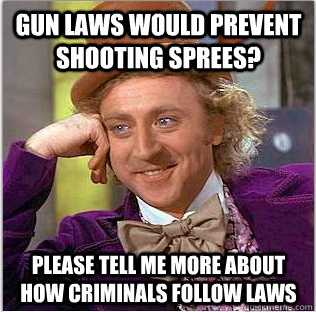Table of Contents
The gun control policy debate is akin to a soccer game. To win the game, each team must play both offensively and defensively; each team must score as many points as possible against the other, while preventing the other from scoring at all. If a team is weak in either offense or defense, that team will not win. In circumstances where the teams’ respective strengths and weaknesses balance each other, the game may at times end in a draw.
In an active policy debate, contenders must also practice both offensive and defensive arguments, and be strong in both skills to win the debate. Offensive argument takes the form of positive assertions about the benefits of one’s position, while defensive argument attacks and weakens any criticisms of one’s position by an opponent, and aims to topple the opponent’s offensive argument as well.
However, unlike soccer, policy debates are seldom fought to a draw. One side or the other makes its points effectively, refutes successfully the arguments of its opponent, and wins the debate.
Defending the Right to Gun Ownership
During the eight years of the Obama Administration, the pro-gun side has taken a beating in the gun control debate. Pro-gun rights proponents have been forced into a defensive position by their opponents every time there is a mass shooting in America. There have been two aspects to this:
-
The pro-gun side tends to slack off on offensive arguments in between such incidents, discontinuing outreach to those who could be swayed to the pro-gun view. This misses the opportunity to build a strong defensive premise that can be used when needed. (Note the difference between gun deaths committed with illegally owned guns vs. legally own guns, in regions with strong gun control laws.)
- News media tend to whip up hysteria over mass shootings, and blow them out of proportion to all other instances of gun deaths—especially shootings that take place in the commission of other kinds of crime. This catches the pro-gun proponents off balance, and automatically forces them to play defense, and takes away from their time on offense.
The pro-gun camp has made another key error: accepting the premises of the anti-gun camp arguments and attempting to dismantle them. The first principle of any debate should be: NEVER accept the premises of the opponent’s arguments. Doing so forces one to be defensive for the entire debate. The team that establishes the premises of a debate controls that debate by forcing the opposing team into the weak position of trying to destroy a premise. For decades, the anti-gun advocates have been masters of establishing their premises, and have forced the pro-gun camp into defense. Pro-gun advocates must now take a leaf from the anti-gun playbook, establish their own premises, and force their opponents to accept them.
Guns Save Lives and Deter Crime
In the gun control debate, the pro-gun side needs to play offense better. Rather than constantly repeating defensive mantras like “Guns don’t kill people, people kill people”, pro-gun advocates should establish the premise that “Guns save lives and deter crime”. Specifically, the pro-gun playbook needs to include aggressive education programs that emphasize the facts of how guns save more lives and deter more crime than they cause. These educational efforts must be constant, rather than trotted out defensively when the media sensationally splashes sporadic incidents of mass shootings over front pages everywhere.
Establishing solid premises requires facts: solid proof. If a premise is like a tabletop, facts are its legs. Without solid facts to stand on, a premise will fall. The pro-gun team must support its premises with solid, factual proof.
There are two different types of proof: anecdotal evidence and statistical evidence. Anecdotal evidence consists of individual stories and specific situations that support a premise. For the anti-gun camp, these are usually mass shootings or shooting deaths of children (at the hands of adults or other children). A recent example is the San Bernardino California massacre, in which an Islamist-radicalized husband and wife team targeted a County Department of Health holiday party, murdering 14 people and injuring 22. Another recent mass shooting is the Sandy Hook massacre, in which a mentally ill man fatally shot 20 children and 6 adults in an elementary school.
Anecdotal evidence is logically weak, but emotionally strong. One situation, or even a half dozen, are not conclusive proof of a premise; however, they appeal to people’s emotions. Anti-gun advocates know this, and cherry-pick such examples for their shock value: the death of a child, or of several people, are immediately horrifying. The pro-gun camp needs to start cherry-picking its own anecdotal evidence that guns save lives. Many such examples exist, but we do not get as much exposure to them as to the gun massacres and child deaths. Pro-gun advocates need anecdotal evidence that supports their premise emotionally. They need to cite cases where gun owners were able to thwart crimes by using guns. But anecdotal evidence alone is insufficient to win a debate.
The second type of proof, statistical evidence, is more logically supportive of one’s premises. Statistical evidence consists of a mass of individual anecdotes stripped of all but the most essential details, and the trends observed by comparing evidence from different times and places. Masses of examples supporting an argument are not isolated, rare cases. They provide the proof that logically and overwhelmingly supports an argument.
Statistical evidence can be organized and classified to show whether a premise is sound. Data sorted by geographic area, by state, by municipalities that enforce gun control, and by those that allow unrestricted, concealed carry and possession, can bolster and prove the case of the pro-gun camp. The statistics in the case of Kennesaw, Georgia—where gun possession is not just legal, but mandatory—and other similar municipalities should be cited frequently. So should the states with less restrictive gun laws, like Vermont, South Dakota, and Maine, where crime rates are lower per capita.
The larger statistical picture across the United States shows that violent crime has been decreasing over the last few years, while support for gun possession and concealed carry has remained relatively constant. Gun sales have also increased in the same period. Pro-gun forces must constantly emphasize these points.
“Tens of Thousands of Crimes are Prevented Each Year by Ordinary Citizens with Guns”
Having made a strong case for its position, the pro-gun camp can and should also proceed defensively, by pointing out the weaknesses in the anti-gun evidence. Note again that the evidence, and NOT the premises, of the anti-gun lobby is being attacked here. Having not accepted the anti-gun premises allows the pro-gun side to point out the weaknesses in the anti-gun proof. For example, the anti-gun side points out that there were over 30,000 gun related deaths in 2013. However, it is not mentioned that two thirds of these deaths were suicides, not homicides. This statistic does not differentiate between gun deaths and gun homicides, and is thus deceptive. It is an important distinction. And when those numbers are adjusted, interesting findings emerge. For example, New Jersey, which has a lower gun death rate, has a relatively high gun murder rate. The difference is nuanced but extremely telling. The data show that when the number of gun suicides is subtracted from the total, gun deaths have not risen; if anything, they have fallen. And states with low gun death rates don’t necessarily have lower gun homicide rates.
Furthermore, it has been found that guns prevent an estimated 2.5 million crimes per year, many without of them without shots even being fired. The Cato Institute reviewed eight years of news stories and came to the conclusion that “the vast majority of gun owners are ethical and competent, and tens of thousands of crimes are prevented each year by ordinary citizens with guns“. Additionally, in a 1986 survey of convicted felons, it was found that 60% said they would avoid committing a crime if they knew the person was armed, while 40% said they wouldn’t commit the assault if they just thought the person was armed.
Mainstream media is sensationalist: it goes straight for shock value. To television, radio, and the newspapers, prevented crimes are not as dramatic as successful ones. Therefore, pro-gun advocates are obligated to keep the evidence that guns prevent crime constantly in the public’s awareness. Not just after every mass shooting, not just after the tragic shooting death of a child, but ALWAYS: 24/7/365.
While support for gun rights has remained largely unchanged in the last decade, pro-gun advocates need to sharpen up their game strategy to win the gun policy debate—which includes learning from their anti-gun opponents.
Happy 50th Birthday to big name in rifles, Ruger – read our full article on the Ruger 10/22 rifle here




No comments yet.